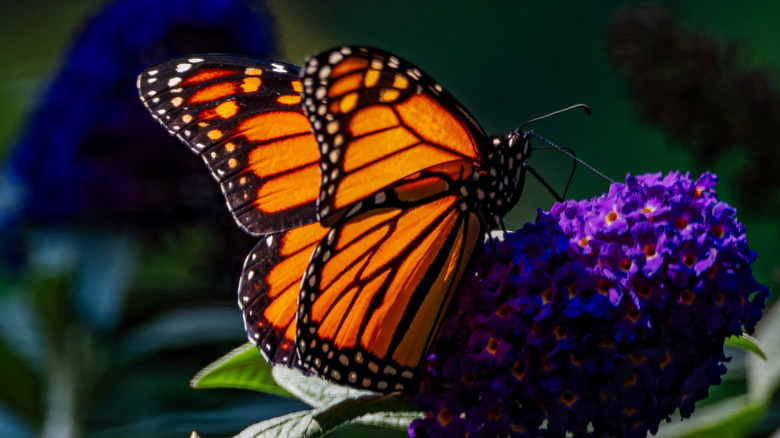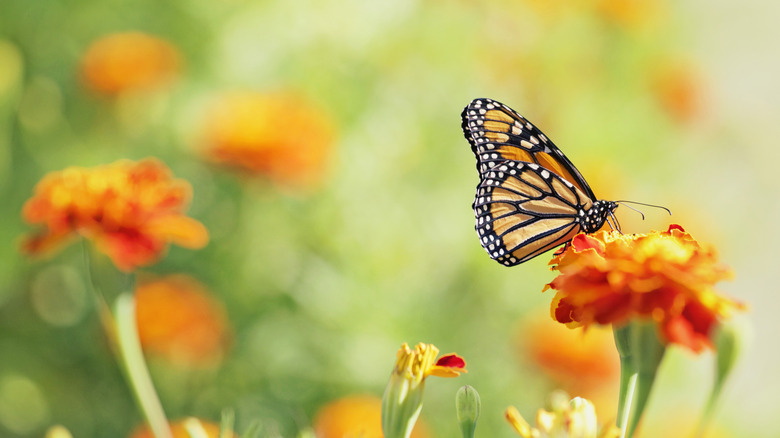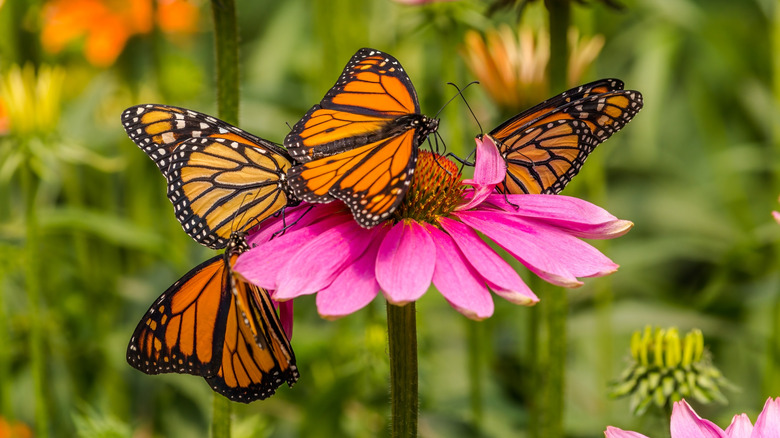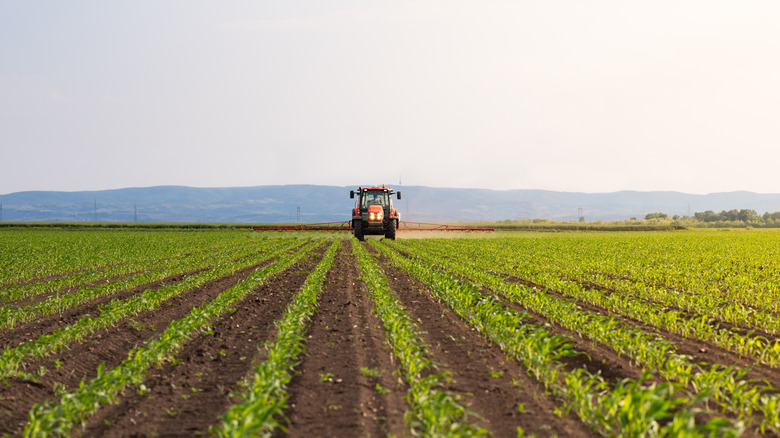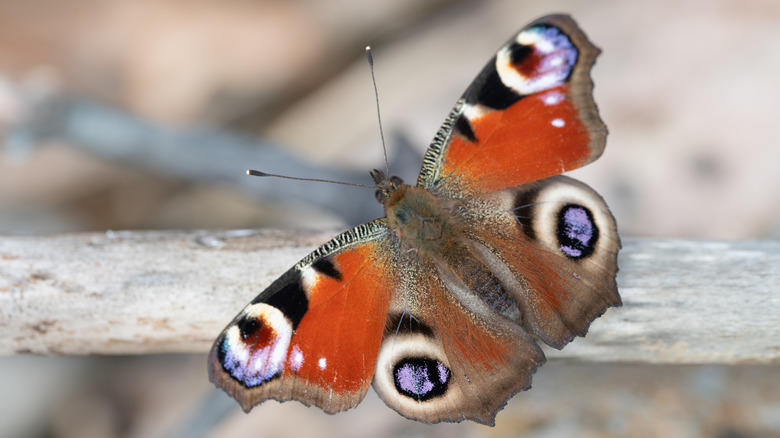Why You're Not Seeing As Many Butterflies Now As You Did When You Were A Kid
Of all the threats to Earth, the global decline of insects might not seem like the most troubling, and perhaps compared to the potential impact of climate change in the coming years, it isn't, but climate change certainly plays a direct role in the ongoing "insect apocalypse." As per a 2022 Reuters report, the global insect population is declining by 2% per year as a result of multiple factors, including pesticides, deforestation, light pollution, and climate change. All of which means that 40% of all insect species are declining worldwide. Since insects account for an incredible two thirds of all species on Earth, this is obviously a hugely concerning trend with what will likely entail disastrous consequences, both environmental and economic, if things don't change.
Sadly, butterflies have not escaped this alarming development. If you feel as though you're seeing fewer butterflies than you used to, you're right, and while not seeing as many pretty butterfly wings might seem like a less pressing issue than say, the fact that crops aren't going to be pollinated if things keep going this way, butterflies play just as vital a role as other insects. As butterflies continue to disappear, here's everything you need to know about why this is happening and what the potential outcomes could be.
Butterflies play an important role
Insects in general are a good thing. Some might look positively terrifying under a microscope, and others are classified as pests, but for the most part, insects actually represent a form of natural pest control, pollinate plants and crops, and help keep soil nutrient-rich and fertile. Butterflies are no different in that regard. Not only do they pollinate plants, helping fruits, vegetables, and flowers to create new seeds, they are a sign of a healthy and thriving natural environment. What's more, butterflies and caterpillars provide sustenance for a wide range of animals, such as birds, lizards, and spiders. As such, they are an important link in the food chain, and their disappearance could have wide-ranging consequences for animals higher up that chain.
This is to say nothing of the importance of butterflies from a scientific research point of view. The winged insects are known to be particularly sensitive to habitat and climate changes, and therefore offer researchers a good proxy for monitoring the impact of both. With this in mind, a significant decline in butterfly numbers goes beyond the tragedy of losing some of nature's most strikingly beautiful creations. So, what's going on with the world's butterfly population?
Butterflies haven't been spared from the insect apocalypse
The ongoing "insect apocalypse" is wiping out entire insect species. A 2020 study published in the journal Biological Conservation claimed that between 5% and 10% of all insect species have been eradicated since the industrial era, which means we've lost between 250,000 and 500,000 species. Butterflies have not been spared.
The order Lepidoptera comprises 160,000 species of butterflies and moths, all of which have taken a significant hit in recent years. Since 1950, five butterfly species have gone extinct in just the United States, and things are only getting worse. A study carried out by a team within the U.S. Geological Survey's John Wesley Powell Center for Analysis and Synthesis and published in the journal Science, found that, in the United States 22% of all butterflies, have disappeared in the last 20 years. Researchers combined data from 35 citizen science programs across the country and found that butterfly numbers had declined across almost all regions. What's more, two thirds of species had declined by more than 10%, and 22 species were found to have declined by more than 90%.
What is driving this dramatic loss in butterfly numbers? Well, as with the wider loss of insects, it's a combination of factors, but it turns out certain factors are more significant depending on the region in question.
Pesticides are killing butterflies in the midwestern United States
Many species of butterfly are currently endangered. The rare Sacramento Mountains checkerspot butterfly, for example, is one of several endangered New Mexico species, and while this is a hyper-local example, the reasons behind the creature's decline speak to the general issues faced by butterflies the world over. A change in wildfire patterns and frequency alongside climate change, invasive plants, and recreation have resulted in severe negative changes to the butterfly's habitat, placing it in peril. According to the U.S. Forest Service, this has all combined to make the Sacramento Mountains checkerspot butterfly the most endangered butterfly in the country (as per the Center for Biological Diversity).
Clearly, then, there are a multitude of factors at play here. In the midwestern United States, however, it seems there could be one specific factor which is causing more harm than all the other issues: pesticides. A 2024 study published in PLoS One looked at 17 years worth of data from 81 counties in five states across the Midwest and found that a loss of butterfly abundance was most closely correlated with a change in insecticide use. In terms of what the researchers called "species richness," the use of neonicotinoid-treated seeds was having a particularly dramatic effect. Again, this isn't necessarily the story worldwide, but it provides an insight into how the issue of butterfly loss looks different across regions.
Butterflies face a multi-faceted threat
Although insecticide use is clearly a major contributing factor to butterfly loss in the midwestern United States, globally there are many other threats faced by butterfly species. The 2025 Science study, found that butterflies in the Southwest have seen the most significant decline, at least in part due to the region's changing climate and the resulting dry conditions. Since butterflies aren't able to retain much moisture, they are particularly susceptible to dry conditions, while droughts also damage plants on which the insects rely to survive.
The Powell Center's researchers also noted that many butterfly species had seen the highest losses in their numbers at the southernmost areas of their ranges, with Eliza Grames, who was involved with the study, noting in a companion piece in The Conversation how either climate change or greater exposure to the use of insecticides in agriculture might be to blame (though she and her fellow researchers weren't able to definitively link causes with effects).
While this all sounds very bleak (and it is), there is still hope. In fact, there are things we as individuals can do to help butterfly population numbers improve. Insects have short generation spans which means that even very slight improvements to natural environments can have a big effect. Something as simple as planting native flowers can almost instantly improve a habitat for butterflies and result in an increase in population. There are also butterfly monitoring programs which anybody can get involved in to help keep track of numbers.
